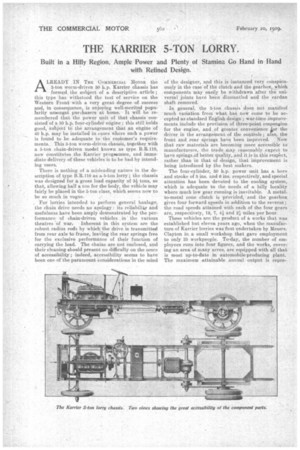THE KARRIER 5-TON LORRY.
Page 10

Page 11

If you've noticed an error in this article please click here to report it so we can fix it.
Built in a Hilly Region, Ample Power and Plenty of Stamina Go Hand in Hand with Refined Design,
ALREADY IN THE COIEUERCIAL MOTOR the 3-ton worm-driven 50 h.p. Earlier chassis has formed. the subject of a descriptive article ; this type has withstood the test of service on the Western Front with a very great degree of success and, in consequence, is enjoying well-merited popularity amongst purchasers at home. It will be remembered that the power unit of that chassis consisted.of a 50 h.p. four-cylinder engine ; this still holds good, ,Subject to the arrangement that an engine of 40 h.p. may be installed in cases where such a power is found to be adequate to the customer's requirements. This 3-ton worm-driven chassis, together with a 5-ton chain-driven model known as type 1.R.110, now constitutes the Karrier programme, and immediate delivery of these vehicles is to be had by intend ing users. .
There is nothing of a misleading nature in the description of type li.R.110 as a 5-ton lorry-; the chassis was designed for a gross load capacity of 51 tons, so that, allowing half a ton for the body, the vehicle may fairly be placed in the 5-ton class, which seems now to be so much in vogue. ... .
-For lorries intended to perform general haulage, the chain drive needs no apology : its reliability and usefulness have been amply demonstrated by the performance of chain-driven vehicles. , in • the various theatres of ware Inherent in this system are the robust radius rods by which the drive is transmitted from rear axle to frame, leaving the rear springs free for the exclusive performance of their function of carrying the load. The chains are not enclosed, and their cleaning should present no difficulty on the score of accessibility ; indeed, accessibility seems to have been one of the paramount Considerations in the mind of the designer, and this is instanced very conspicuously in the case.of the clutch and the gearbox, which components may easily be withdrawn after the universal joints have been dismantled and the cardan shaft removed.
In general, the 5-ton chassis does not manifest much variation from what has noW come to be accepted as standard English design ; war-time improvements include the provision of three-point suspension for the engine, and, of greater convenience kr the driver in the arrangement of the controls ; also, the front and rear springs have been improved. Now that raw materials are becoming more accessible to manufacturers, the trade may. reasonably expect to have springs of better quality, and it is in this respect, rather than in that of design, that improvement is being introdiiced by the best makers.
The four-cylinder, 60 h.p. power unit has a. bore and stroke of 5 ins. and 6 ins, respectively, and special attention has been devoted to the cooling system, which is adequate to the needs of a hilly locality where much low gear running is inevitable. A metalto-metal cone clutch is provided, and the gearbox gives four forward speeds in addition to the reverse; the road speeds attained with each of the four gears are, respectively, 12, 7, ell and 21 miles per boor.
These vehicles are the pro-duct of a works that. was established but eleven years ago, when the manufacture of Karrier lorries was first undertaken by Messrs. Clayton in a small workshop that gave employment to only 35 workpeople. To-day, the number of employees runs into four figures, and the works, covet-7 ing an area of many acres, are equipped with all that is most up-to-date in automobile-producing plant. The maximum attainable annual output is repre Year of the existence of the works, 15 lorries were completed ; this output was raised to 40 in the third year, and it is satisfactory to note that many of the earlier Karrier lorries are still giving good service in the hilly districts of Yorkshire and Derbyshire.
As a result of the War Department Subsidy trials, held in October, 1913, Messrs. Clayton were given orders for Several vehicles, and it Wa0 a fortunate • equipment of the original Expeditionary Force. Many thousands of Kamer lorries have since been supplied to the War 'Office for service in all the theatres of war. Not the War Office only, however, is an extensive buyer of Karrier lorries, for amongst Messrs. Clayton's other important customers are also to be included several railway companies, including the London and South Western; the Great Central, and the London and North Western.






















